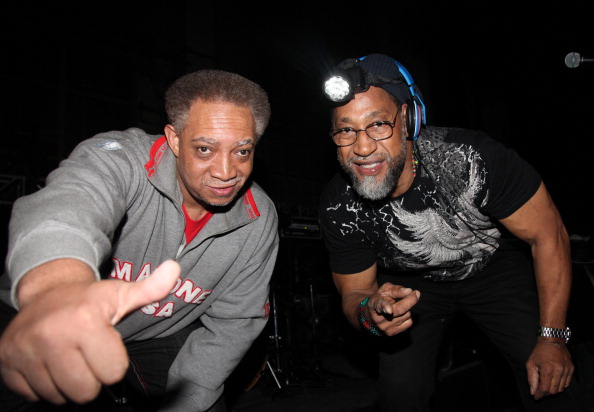
Source: Johnny Nunez / Getty
Hip-hop originating in The Bronx will always make the East Coast a focal point of the culture, especially when discussing the pillar of DJing. Even at its roots with late NYC club king Francis Grasso, credited as being the godfather of beatmatching and the club mix during the 1960s, the origins for any disc jockey will always trace back to the Atlantic Coast.

Source: Peter Kramer / Getty

Source: Peter Noble / Getty

Source: Al Pereira / Getty

Source: Al Pereira / Getty

Source: PYMCA/Avalon / Getty
East Coast DJs have a place in the culture from the very beginning, starting with that 1973 community room party at 1520 Sedgwick Ave hosted by the “Father of Hip-Hop” himself, DJ Kool Herc. Through his invention of “the break,” rap culture elevated in ways that provided the b-boys and b-girls at the helm of the movement something to, well, move to. One b-boy in particular, GrandMixer DXT, went on to mix things up even further as the first DJ to use a turntable as a musical instrument. The classic 1983 film Wild Style perfectly illustrates this era in hip-hop to a tee.

Source: Chris Carroll / Getty

Source: Ron Galella / Getty

Source: Images Press / Getty

Source: Michael Ochs Archives / Getty

Source: Michael Ochs Archives / Getty

Source: Al Pereira / Getty
From there, pioneers like Grandmaster Flash, DJ Grand Wizard Theodore, Kool DJ Red Alert and DJ Scratch were each creating core techniques to the craft — record scratching, punch phrasing, breaking the barrier of broadcast radio and even defining what a mixtape was were all part of the plan. As we moved from the late ’80s into the 1990s, a proverbial gold rush of DJs hailing from the East Coast enter the conversation and further pushed the genre forward. DJs are impacting the music industry in a huge way at this point, with legends like DJ Jazzy Jeff, the late Jam Master Jay, DJ Polo, Eric B., Pete Rock and DJ Spinderella each lending their turntable skills to the Billboard hits of Will Smith, Run-D.M.C., Kool G Rap, Rakim, CL Smooth and Salt-N-Pepa, respectively.

Source: Al Pereira / Getty

Source: Al Pereira / Getty

Source: Julia Beverly / Getty
Solo stars also found a way to highlight the DJ in their own way: Mister Cee got his own song on Big Daddy Kane’s debut album, Kid Capri lended heavily to the chorus of the late Big L’s debut single, Swizz Beatz gave DMX the “anthem” that jumpstarted his much-too-short career and the recently departed DJ Clark Kent helped Dana Dane strike gold on his debut LP. Others got in the game as artists themselves, primarily with DJ Premier and the legacy of Gang Starr. Red Alert’s reign on radio led to other impactful DJs that followed suit, including DJ Chuck Chillout and the inescapable signature bomb effects of Funkmaster Flex. DJ Stretch Armstrong took it a step further and brought college radio into the conversation during his days at Columbia University.

Source: PYMCA/Avalon / Getty

Source: Johnny Nunez / Getty

Source: Patrick McMullan / Getty

Source: Al Pereira / Getty
In a similar fashion, successors of Scratch elevated the mixtape era to peak levels: DJ Clue, DJ Green Lantern, DJ Whoo Kid, Statik Selektah, Tony Touch and the late DJ Kay Slay each had a tape series that kept the streets in a chokehold. Actually, the work each of these guys put in during the early to mid 2000s set them up to be the new age legends to those shaping their DJ careers in the East Coast today.

Source: James Devaney / Getty

Source: Johnny Nunez / Getty

Source: Johnny Nunez / Getty

Source: Chris Weeks / Getty

Source: Jun Sato / Getty

Source: Johnny Nunez / Getty
With the influx of rising East Coast DJs coming into the game today, from Austin Millz out of Harlem and Jam Master Jay’s son T.J. Mizell carrying on the legacy of both his father and the borough of Queens to the DMV’s own DJ B-Hen and genre-bending siren Suzi Analogue, let’s just say the art of mixing is in good hands.
They don’t call it the Beast Coast for nothing!

Source: Clive Mason – Formula 1 / Getty

Source: John Sciulli / Getty

Source: Craig Barritt / Getty

Source: Dave Benett / Getty
Enjoy this special Hip-Hop History Month salute to East Coast DJs with a selection of music below inspired by the mixmasters mentioned above:
Kool Herc
GrandMixer DXT
DJ Grand Wizard Theodore
Grandmaster Flash
Kool DJ Red Alert
DJ Scratch
DJ Chuck Chillout
DJ Jazzy Jeff
DJ Jam Master Jay
Spinderella
Mister Cee
Kid Capri
DJ Clark Kent
DJ Premier
DJ Polo
Swizz Beatz
Funkmaster Flex
DJ Stretch Armstrong
DJ Kay Slay
DJ Clue
DJ Green Lantern
DJ Whoo Kid
Tony Touch
Austin Millz
B-Hen
Suzi Analogue
T.J. Mizelll

